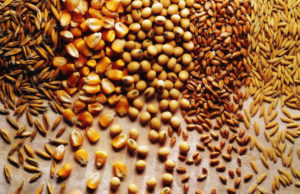 Grain futures were little changed on Wednesday. Soybeans were pressured on signs for abundant global supplies, while wheat traded near two-month low levels after the USDA reported planting of the U.S. crop accelerated last week and surpassed the five-year average pace.
Grain futures were little changed on Wednesday. Soybeans were pressured on signs for abundant global supplies, while wheat traded near two-month low levels after the USDA reported planting of the U.S. crop accelerated last week and surpassed the five-year average pace.
On the Chicago Board of Trade, wheat futures for settlement in December traded at $6.4563 per bushel at 10:32 GMT, up 0.07% on the day. Prices plunged to a session low of $6.4538 per bushel, near Tuesdays two-month low of $6.4488 a bushel, while days high was touched at $6.4775. The grain lost 0.2% yesterday, a tenth consecutive daily retreat, and was down 0.4% on weekly basis on Wednesday.
Wheat was pressured after the U.S. Department of Agriculture reported on Tuesday that the planting process of the U.S. crop accelerated last week and neared completion. The USDA said that 95% of wheat was planted through the week ended November 10, above the five-year average of 93% and last years 94% during the comparable period. Meanwhile, 84% of plants had emerged last week, exceeding the average of 80% and 2012s 78% during the same period.
Also fanning negative sentiment, the government agency said last week that U.S. wheat inventories will be 565 million bushels at the end of the current marketing year, up from previously estimated at 527 million.
Meanwhile, DTN reported on November 12 that episodes of scattered showers and mild weather will favor the pre-winter development of winter wheat in the Southern Plains with no damage from cold snap being expected this week. DTNs forecast also called for favorable rains in Brazil and suitable conditions for wheats heading stage in Argentina.
Corn and soybeans little changed
Elsewhere on the market, soybeans futures for settlement in January traded at $13.1600 a bushel at 10:32 GMT, up 0.12% on the day. Prices held in range between days high of $13.1688, near Tuesdays 1-1/2-month high, and low of $13.1063 a bushel. The oilseed added nearly 1.1% yesterday, a fifth straight daily gain, and extended its weekly advance to 1.6% on Wednesday.
Soybeans drew support earlier in the week after the USDA reported that global inventories before the next year’s harvest will be 70.23 million tons, below September’s estimate of 71.54 million tons. U.S. production will be 3.258 billion bushels this year, the third-biggest ever. Data also showed U.S. exporters sold 1.018 million tons of soybeans in the five days to October 31, more than five times the amount during the comparable period a year earlier.
The USDA raised its forecast for soybeans exports in the current year to 1.45 billion bushels, up from previously estimated at 1.37 billion.
Gains were however limited after Oil World said yesterday that global output may be 4 to 5 million tons larger than previously projected. The researcher estimated the 2013-2014 global production at 281.3 million tons on October 22, up 5.4% from a year earlier, while the USDA revised up its previous prediction to a record 283.54 million tons last Friday from 281.66 million in September.
The government agency also reported yesterday that the U.S. harvest advanced by 5% from a week earlier. As of November 10, 91% of soybeans were harvested, 1% less than the five-year average and below last years 95% during the comparable week.
Elsewhere on the market, corn futures for settlement in December were almost unchanged at $4.3263 per bushel at 10:32 GMT, up 0.01% on the day. Prices shifted in a narrow range between $4.3313 and $4.3188 a bushel respectively. The grain lost 0.6% on Tuesday but was up 1.5% on weekly basis on Wednesday.
Corn recently drew support after the USDA said on November 8 that U.S. farmers will harvest 13.989 billion bushels in the 2013 marketing season, below expectations for a revision to 14.029 billion. Meanwhile, U.S. corn inventories were expected to be 1.887 billion bushels in the year ending August 31, well below previous projections for 2.056 billion. U.S. suppliers are forecast to export 1.4 billion bushels, 14% more than previously calculated as importers will likely take advantage of low prices, which recently slipped to the lowest in 38- months.
Meanwhile, the government agency said in its crop progress report yesterday that the U.S. harvest accelerated by 11% last week. As of November 10, U.S. farmers had collected 84% of corn, 5% above the five-year average but below last years 97% during the comparable week.
Soybeans and corn were also pressured on outlook for favorable weather throughout some of the worlds major growing areas. DTN reported yesterday that dry and cold weather in the U.S. Midwest will favor the remaining harvest during the next five days. The agency also said that light rainfall in Brazils southern crop areas will favor planting, especially in the Rio Grande do Sul state. Argentinas crop areas continue to have favorable conditions for planting row crops.
DTNs report also showed that weekend showers across the North China Plain and Yangtze River valley recharged soil moisture, favorable for developing winter grains and oilseeds. Drier weather is likely during the next seven days. In South Africa, light showers across the Maize Triangle region recharged some soil moisture after a recent hotter and drier trend provided suitable conditions for planting but also increased stress to crops, DTN said. More showers and cooler weather later this week or early next week were included in the agencys outlook.





